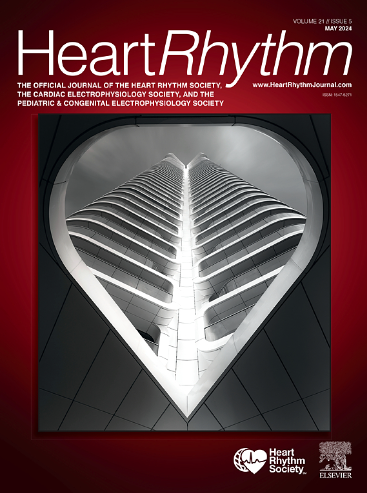肥厚性心肌病患者不同种族队列心房颤动风险预测工具的外部验证
IF 5.7
2区 医学
Q1 CARDIAC & CARDIOVASCULAR SYSTEMS
引用次数: 0
摘要
背景:房颤(AF)是肥厚性心肌病(HCM)患者中最常见的持续性心律失常。2024年AHA/ACC指南推荐经过验证的临床工具,如HCM-AF评分,用于房颤风险的个性化评估。迄今为止,这些工具仅在以白人HCM为主的患者群体中得到验证。目的:比较已发表的房颤风险预测工具在不同种族HCM患者队列中的表现。方法:这是一项在约翰霍普金斯HCM中心评估的无房颤HCM患者的回顾性研究。使用HCM-AF评分和其他非hcm特异性风险评分(C2HEST、HARMS2-AF、CHA2DS2-VASc和CHARGE-AF)对房颤风险进行评估。对患者进行纵向随访,以确定是否有新发的、具有临床意义的房颤。采用基于一致性的c统计来评估歧视。结果:纳入HCM患者631例,平均年龄55.9±15.3岁;49.7%为女性,64.7%为白人,24.1%为黑人,11.2%为其他非白人种族。在中位随访3.1年期间,18.9%的患者被诊断为新的房颤。HCM-AF评分比其他非hcm特异性风险评分(c-统计量:0.72)表现出更好的风险区分(c-统计量:0.56-0.67),并有效地将患者分为低危(0.9% AF/年)、中危(3.4% AF/年)和高危(7.4% AF/年)组。白人(c-statistic: 0.71)和非白人(c-statistic: 0.74)患者的HCM-AF评分对房颤风险的区分相似。结论:HCM-AF评分在不同HCM患者队列中表现出良好的房颤风险区分,优于其他非HCM特异性房颤风险评分,并验证了其在非白种人HCM人群中的应用。本文章由计算机程序翻译,如有差异,请以英文原文为准。
External validation of atrial fibrillation risk prediction tools in a racially diverse cohort of patients with hypertrophic cardiomyopathy
Background
Atrial fibrillation (AF) is the most common sustained arrhythmia in patients with hypertrophic cardiomyopathy (HCM). The 2024 American Heart Association/American College of Cardiology guidelines recommend validated clinical tools such as the HCM-AF score for individualized assessment of AF risk. To date, these tools have been validated only in predominantly white HCM patient populations.
Objective
This study aimed to compare the performances of published AF risk prediction tools in a racially diverse cohort of patients with HCM.
Methods
This was a retrospective study of patients with HCM without previous AF evaluated at the Johns Hopkins HCM Center. Assessments of AF risk were generated using the HCM-AF score and other non-HCM-specific risk scores (C2HEST, HARMS2-AF, CHA2DS2-VASc, and CHARGE-AF). Patients were followed longitudinally for the development of new-onset, clinically significant AF. Discrimination was assessed using concordance-based c-statistics.
Results
A total of 631 patients with HCM were included, with a mean age of 55.9 ± 15.3 years; 49.7% were women, 64.7% were white, 24.1% were black, and 11.2% identified with other nonwhite race. During a median follow-up of 3.1 years, new AF was diagnosed in 18.9% of patients. The HCM-AF score demonstrated better risk discrimination (c-statistic 0.72) than other non-HCM-specific risk scores (c-statistics 0.56–0.67) and effectively stratified patients into low-risk (0.9% AF/year), medium-risk (3.4% AF/year), and high-risk groups (7.4% AF/year). Discrimination of AF risk by the HCM-AF score was similar for white (c-statistic 0.71) and nonwhite patients (c-statistic 0.74).
Conclusion
The HCM-AF score demonstrated good AF risk discrimination in a diverse cohort of patients with HCM, outperforming alternative non-HCM-specific AF risk scores and validating its use in nonwhite HCM populations.
求助全文
通过发布文献求助,成功后即可免费获取论文全文。
去求助
来源期刊

Heart rhythm
医学-心血管系统
CiteScore
10.50
自引率
5.50%
发文量
1465
审稿时长
24 days
期刊介绍:
HeartRhythm, the official Journal of the Heart Rhythm Society and the Cardiac Electrophysiology Society, is a unique journal for fundamental discovery and clinical applicability.
HeartRhythm integrates the entire cardiac electrophysiology (EP) community from basic and clinical academic researchers, private practitioners, engineers, allied professionals, industry, and trainees, all of whom are vital and interdependent members of our EP community.
The Heart Rhythm Society is the international leader in science, education, and advocacy for cardiac arrhythmia professionals and patients, and the primary information resource on heart rhythm disorders. Its mission is to improve the care of patients by promoting research, education, and optimal health care policies and standards.
 求助内容:
求助内容: 应助结果提醒方式:
应助结果提醒方式:


